Sometimes, you just get a perfect draw.
Sometimes your opponent plays a Burning Inquiry, discards 2 Vengevines and a dud, then runs out 3 Hollow Ones and leaves you staring down 20 power on the first turn, 8 of which has haste. Every once in a while, you mulligan in standard and draw 2 Mountains, a Ghitu Lavarunner, a Runaway Steam-Kin, a Light up the Stage, and a Wizard’s Lightning, and you just know your opponent won’t get a third turn. I was playing a Vintage tournament online once, mulled down to four, and got a hand of a land, Black Lotus, Necropotence, and Duress. I didn’t lose that game.
We love talking about these hands, hearing about them, and most of all drawing them. The problem is, they’re not very common. In fact, those perfect draws are so rare they’re nicknamed “magical christmasland”. Sure, there are hands you could draw that will win the game on the first upkeep, and one time out of a million, you’ll get an incredible story. But the other 999,999 times, all you’ve got is a crappy deck full of mediocre cards and no way to beat that turn-1 Thoughtseize. The sad truth is, the craziest god draws are so inconsistent, you could never build a deck that would get them with any reliability.
But what if you could? What if, when you built your janky glass cannon, not only would you get your perfect draw often enough to enjoy it, you got it every single game?
What if everything always went right?
Today, we will test the limits of what you can do with a perfect draw. We will see broken opening hands clash with broken opening hands. We will explore the diverse strategies you might bring to bear in a tournament with these rules. And we will see the rough outline of a metagame take shape.
1. The Rules
I’m using the Modern cardpool for this experiment. Standard is just too boring, and the eternal formats have a few too many moving parts. Modern is also famous for being full of broken glass cannons, so when it comes to busted draws, it’s a natural fit.
The banned list still applies, of course. Surprisingly, I don’t think that would make much difference, but it’s there. There’s still a 60 card minimum and the 4-of limit still applies. Every game played in this experiment is theoretically possible in the next Modern tournament you go to.
There is only one change: you control all randomness created by your deck. You decide every card in your opening hand, and what card you draw. Your only limitation is that you can’t go into your deck and change the order in the middle of the game. Cards in your library don’t spontaneously swap places in-game. Rule of thumb: you get to reorder your library however you want every time you would shuffle it, including before you start the game. If you want to reorder your library in response to something your opponent does, you have to get a shuffle effect.
There is one exception to this: in Magic, you decide who goes first before you draw your opening hand. That means that you can change you hand based on whether you’re on the play or on the draw. Neither of these rules are crucial, but they will be important later on.
Lastly, you’re not the only one with this ability. Your opponent also gets their god draw. They can use their hand either to counter what you’re doing, or to race you with their own broken strategy.
Enough chit-chat. On to the lists!
2. The Broken Stuff
We’ll start by looking at the first strategy I thought of, and probably the cleanest one. Your opening 7 would look something like this:
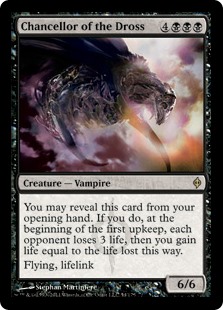



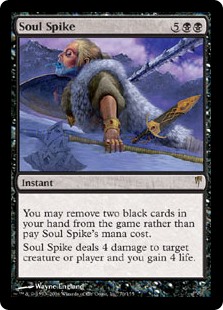

On the beginning of the first upkeep, you reveal four Chancellor of the Dross from your opening hand, and get four triggers. Then, either after they resolve or in response, you cast the two Soul Spikes, pitching two Chancellors to each one. The Chancellor triggers drain your opponent for 12, and the Spikes cover the remaining 8. Your opponent takes 20 before the first draw step. You even have a spare spot for some form of protection like Pact of Negation. Easy peasy.
The problem is, this kill is incredibly fragile. Any interaction, either opposing Soul Spikes, a Commandeer, or a Chancellor of the Annex, will fizzle it. And all of them require different tools. Soul Spike and Commandeer need a counterspell, but Chancellor needs either a mana source or a 0-mana spell it can use to absorb the trigger before casting the Spikes. But more importantly, it has no answer to a single Leyline of Sanctity.
It’s also even weaker on the play, for two reasons. The first is Force of Negation. To understand the second, we need to talk about APNAP. APNAP stands for “Active Player, Non-Active Player”, and it’s an obscure rule determining the order that triggered abilities go on the stack, when multiple abilities from different players all trigger simultaneously. The Active Player (usually, the one whose turn it is) goes on first, then the Non-Active player goes on top of that.
In other words, if both players have abilities triggering on the first upkeep, the player going second’s ones resolve.
Imagine you’re playing Dross-Spike, but your opponent also has a Chancellor of the Dross in hand. If you’re on the draw, your Dross triggers resolve before your opponent’s. Then, in response to their trigger, you can cast the Soul Spikes, killing your opponent before they get their upkeep abilities. But if you’re on the play, your abilities go on the bottom. You can still get the Soul Spikes first, but the opponent will survive to resolve their Chancellor trigger.
There is no room for error in the Dross-Spike hand. it deals exactly 20. If the opponent is on the draw and has a single Chancellor of the Dross, they won’t die, you’ll have spent your whole hand bringing them to 3, and they’ll still have 5 cards to kill you and fizzle whatever you topdeck.
APNAP, along with the power of Gemstone Caverns and the force cycle from Modern Horizons, means that most of the time it’s better to go second than to go first in this format. There are very few exceptions. The next hand is one of them.



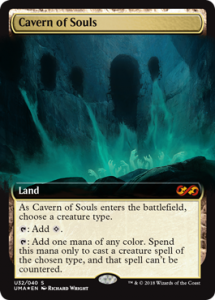
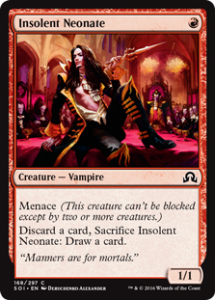

Like the Dross-Spike hand, this version starts with some Chancellor triggers. This time, you only need three, putting your opponent to 11. Then, come the main phase, you play Cavern of Souls and tap it to cast Insolent Neonate. You sacrifice the Neonate, discarding Stinkweed Imp and dredging. You dredge up a card of your choice (probably another Stinkweed Imp, for durability), and four copies of Creeping Chill. They each trigger, draining your opponent for a further 12. They take 21 and die.
While this version is more convoluted and sorcery speed, it’s resilient to a lot of the hate you’d throw at the Dross-Spike combo. Neither Creeping Chill nor Chancellor’s trigger target, so this version gets around Leyline of Sanctity. The only spell you have to cast, Insolent Neonate, is uncounterable, so all countermagic is irrelevant. It’s also a creature, so Commandeer won’t do it either. And while it’s too slow to protect you from Dross-Spike on its own, it has an extra spot for a Leyline of Sanctity. When the dust settles, it will still have a Stinkweed Imp in its graveyard, allowing it to set up for a finishing blow with Prized Amalgams or something.
At the same time, it has its own Leyline problem: Leyline of the Void. No graveyard, no dredging. And it’s not like you can hope they mulligan to oblivion looking for it.
Is there any kill that isn’t so easily disrupted? Yes and no. Allow me to introduce you:

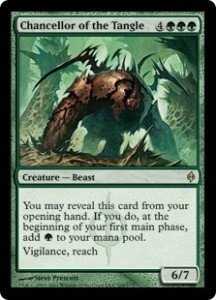
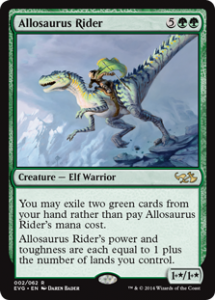
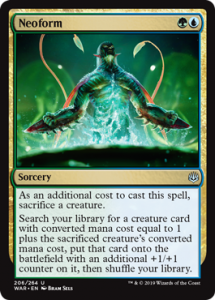
There are a few different variants of this hand, of course, depending on whether you’re aiming for Eldritch Evolution or Neoform, but those are minor details. In general, you generate some mana with Chancellor of the Tangle, then pitch it (and a fifth green card) to cast Allosaurus Rider. You then immediately sac it to Neoform, and search out a Griselbrand. You pay 7 life and draw seven cards, two of which are Autochton Wurm and Nourishing Shoal (the rest can be free countermagic, disruption, etc.). You use them to gain 15 life, which lets you draw fourteen more cards. You keep going like this until you draw your entire deck, generate some mana, cast a Laboratory Maniac and some cantrip (or just activate Griselbrand again), and win.
This kill never targets the opponent. It bypasses the graveyard completely. And where the other two hands had six mandatory cards and only one slot for disruption, this one has two. On the draw, it can play a Chancellor of the Dross, leaving it at 3 life vs Dross-Spike and 2 vs Dredge, and Pact of Negation, drawing a SECOND Pact on its turn for further protection. On the play, it can run Leyline Sanctity and Pact of Negation, and just kill the dredge player before they can go off. No matter what card the other strategies use to fill their seventh slot, this deck can beat it. And because it has two slots for protection in general, it’s that much harder to disrupt it through other means.
Harder, not impossible. Two slots are enough to stop both Dredge and Dross-Spike kills, but they aren’t enough to protect the combo from a full range of disruption. Neoform and Evolution are both tempting targets for Force of Negation (which is always live against you, since you can only combo off at sorcery speed), and while you can run two Pacts, your opponent can run three Forces plus fodder. Chancellor of the Annex requires its own dedicated tool (Ornithopter, which can eat all the triggers and clear the way for more important spells), which means that even on the draw, you can’t beat an opposing hand of Chancellor of the Annex and three Force of Negations. And of course, there’s always Flusterstorm, playable through Gemstone Cavern if you’re on the play or naturally if you’re on the draw.
While there are many, many other viable turn-1 kills, I don’t believe any of them can match the effectiveness of the ones I’ve laid out here, and I’m certain that none of them can guarantee a win. There are simply too many hoops to jump through. Bear in mind that a guaranteed kill:
- Can’t involve targeting your opponent
- Can’t use the graveyard
- Can’t expose any spell to countermagic, particularly noncreatures.
- Must either go off on the first upkeep, or have space to disrupt the Dross-Spike combo AND not care if the opponent is on 32 life from Dross triggers.
You can avoid some of these restrictions, but every one costs slots. To target your opponent or use the graveyard, you need the ability to remove multiple enchantments, through countermagic, before starting your combo. You can buy yourself time to play a land, but then you need to always have room for a Leyline of Sanctity. With a four-card kill, you might be able to win a counter war, but only if you can avoid a Flusterstorm. And if you can manage all that…
You’ll just run into other, more involved answers. It takes a lot of slots, but Leyline of Anticipation, Leyline of Lifeforce, Simian Spirit Guide, and Wild Cantor let your opponent play anything from Angel’s Grace to Trickbind. At the end of the day, Magic is an interactive game. You can find as many angles of attack as you want, but there will always be a countermeasure.
3. Playing Defense
While I couldn’t find a guaranteed combo kill, I did find ones that required very different answers. The Dross-Spike plan is vulnerable to countermagic (though you can’t rely on Force of Negation since you might be on the play) and Leyline of Sanctity. Both of those are useless against the dredge kill, which is only vulnerable to Leyline of the Void (and a few other tools, like Ravenous Trap, which aren’t any better). The Griselbrand combo is susceptible to countermagic, but not to either of the Leylines. You also need at least three counterspells, or Flusterstorm and a way to reliably cast it on both the play and the draw.
That seems like a lot, but I’ve found a configuration that can shield you from all of them. This is where the rules of deck ordering comes in: the cards you use change depending on whether you’re going first or second.
If you’re going first, you use:
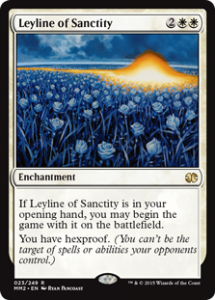
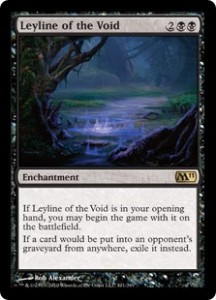
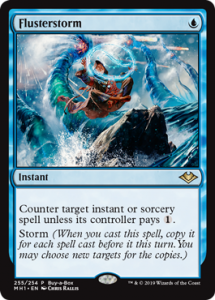

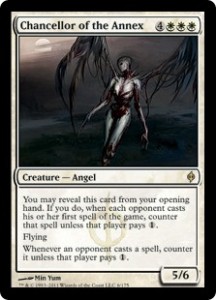
And if you’re going second, you use:

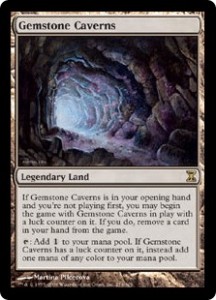


Note that, even though Gemstone Caverns requires you to exile a card, you can reveal Chancellor of the Annex and then exile it, so on the draw you only use four cards. On the play, you have two cards in your opener with which to win. On the draw, you have three, plus the card you draw on the first turn.
If you’re on the play, the two Leylines do most of the work. Sanctity means the Dross-Spike character can’t Spike you, so you wind up at 8 life, your opponent at 32, but you have a five-card hand and they have six useless duds. The Void prevents the dredge player from going off, so you wind up at 11 life, while your opponent is at 29, has a 1/1 Menace and a Cavern of Souls set to vampire, and is drawing nothing but Creeping Chills for the next several turns. And against the Griselbrand deck, Chancellor means they have to use one of their three (remember, they draw up to eight) free slots to either pay for the Chancellor or play a free spell to absorb the trigger. Either way, when you Flusterstorm their tutor spell, they’ll have only 2 cards against a Flusterstorm with a storm count of at least 3. There’s no combination of cards they can use to push past that.
On the draw, you can’t rely on Flusterstorm alone to save you from Griselbrand combo. You need a Gemstone Caverns to provide the mana. On the bright side, the caverns can replace not just your Island, but also Leyline of Sanctity: you can wait for the second Soul Spike, then counter it with Flusterstorm. They have to use their seventh card to get around your Chancellor, so this deterministically beats them. You wind up at 4 life, with one land on the field and four cards in hand, against an opponent who has 1 card left on both the hand and battlefield.
Once the mayhem of the first turn passes and both players enter the midgame, card and mana advantage become hugely important. Because both players have such good selection, and because you’re almost guaranteed to dump most of your hand fighting over turn 1, each new card you draw is hugely impactful. Likewise, players with better mana selection later on have a huge advantage, since they don’t have to draw more lands to unlock new spells. When the first turn is over in these matchups, the control deck has only one land and two cards in hand. But I would give it a 99% chance of winning those games, every time.
It is not, however, the perfect strategy. It can still be exploited, just not on the first turn. Imagine, for instance, a start like this:

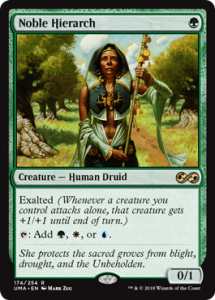
Let’s say our control player is on the play. They’re defending against a strategy that doesn’t abuse the graveyard, doesn’t try to target you, doesn’t rely on instants or sorceries, and just ignored the Chancellor trigger. Four of the cards in their opener are dead. After their land, they have two cards in hand and whatever they topdeck to deal with an optimized Humans draw.
Of course, there’s no way for the humans deck on the draw to protect itself from all the glass cannons. Even if it runs both Leylines in its opener, it still needs a way to deal with the Neoform combo through a Pact of Negation. At a bare minimum, that will take two more cards, at which point our tempo player is rapidly running out of slots to curve out with. In order to exploit the defensive posture of the control strategy, you have to open yourself up to the glass cannons.
And just like that, we have a metagame, with no less than four distinct archetypes:
- The control strategy knocks out the Chancellor of the Dross-based glass cannons and Neoform, but loses to tempo and aggro strategies that exploit its defensive stance.
- The tempo and aggro strategies have a leg up against control, but struggle against either the Dross combos or Neoform, depending on which one they underprepare for. Chances are this is Neoform, because it’s the hardest to fight for them.
- Neoform combo beats the Dross combos and probably the aggro/tempo strategies, but loses to control.
- The Dross combos are lower-tier, but whenever other players skimp on their Leylines, they suddenly dominate.
Note that I say “strategies”, not “decks”. That’s because there’s nothing stopping you from playing several of these at once! With 60-card decks, you can always run four Chancellor of the Dross and two Soul Spike, and just leave them on the bottom of your deck when you don’t go for that combo. Likewise for Dredge, or even the Neoform strategy. This implies something unique about this format: it’s likely that it both has an unquestioned top deck that dominates all others, AND has a thriving and vibrant metagame with aggro, tempo, control, and combo all represented! You just decide which one you are at the start of each game, rather than at the start of each tournament.
Conclusion
God-Draw Modern does not look like a fun format. Based on this experiment, every game would end on the first turn. The perfect draws transform slightly-favored matchups into curbstomps, and crawling back from even a minor disadvantage is almost impossible.
And yet, even in this crazed experiment, it’s not just a goldfish race. Before the first turn begins, both sides already start interacting and deploying competing answers. There is a metagame with no clear best deck. And even in this world where decks can goldfish on turn 0 with 100% consistency, that metagame is defined but by how much the fair decks prepare for the mirror, not the combo decks they beat on. You can change fundamental rules of Magic: the Gathering, and it will still have multiple viable strategies.
Of course, I’ve probably missed something. If you have a better line that flips a matchup, or if you think you’ve found a deterministic win, drop a comment and let me know. If somebody finds something that obsoletes this meta, I’ll write an update.
Until then, may your openers be as good as the ones in this post!